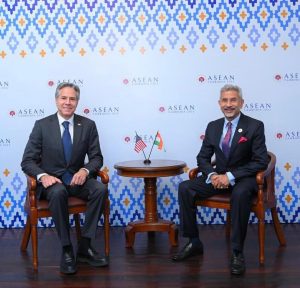Mohamed Zeeshan

India’s Minister for External Affairs S. Jaishankar (right) with U.S. Secretary of State Antony Blinken at a meeting on the sidelines of the ASEAN-India summit in Phnom Penh, Cambodia, Nov. 13, 2022.Credit: Twitter/ Dr S. Jaishankar
At an annual preview of Indo-Pacific issues in Washington this month, the White House coordinator for Indo-Pacific affairs, Kurt Campbell, was very clear about what the United States wants for 2023. “Our interests are to see India playing an ever larger, responsible role in almost everything that we’re doing,” he said.
That’s been a long-standing objective in U.S. foreign policy, and this seems as good a year as any to push India more proactively, given that New Delhi will play host to a pivotal G-20 Summit in 2023.
But so far as Washington is concerned, the road to a no-holds-barred partnership with India will not be without challenges. Through much of 2022, Washington was frustrated by India’s unwillingness to use its seat on the U.N. Security Council to act against various rivals. India abstained on sundry resolutions on Ukraine, Iran, and even Myanmar. India also sat mum through Chinese provocations around Taiwan.
This year, alongside the G-20, India will also hold the presidency of the Shanghai Cooperation Organization (SCO) led by China and Russia — a forum that in recent times has highlighted the burgeoning common ground between the three countries.
If Washington is going into 2023 hoping that it can pull India into a countervailing coalition against Russia or even China in the Indo-Pacific, it’s going to be disappointed. With Russia, India’s security and economic ties remain robust. And despite border tensions with China, New Delhi remains wary of confrontation with Beijing — particularly on issues that it doesn’t perceive to be directly relevant to its own interests, such as Taiwan.
To that end, both India and the United States might welcome the sudden military resurgence of other powers in the region.
While Campbell was speaking about India in Washington, Japan’s Prime Minister Kishida Fumio was on a tour of the West, reinventing his country’s military posture in East Asia. Last month, Japan unveiled an unprecedented overhaul of its previously pacifist policies. Tokyo now aims to hike its military budget to 2 percent of GDP, which would make it the third-largest in the world, and plans to acquire long-range missiles to target China and North Korea.
Meanwhile, amid a record-breaking barrage of missile launches from North Korea, South Korea’s president, Yoon Suk-yeol, pondered aloud about walking out of the Nuclear Non-Proliferation Treaty. “It’s possible that the problem gets worse and our country will introduce tactical nuclear weapons or build them on our own,” he said.
All this comes close on the heels of last year’s AUKUS deal between Australia, the U.K., and the U.S., which gave Australia access to nuclear-powered submarines.
For Washington, this sudden rise of alternative military partners across Asia means that there is no longer a need to press New Delhi to align with itself on sensitive geopolitical issues — or to push India into an alliance against China or Russia. But what the United States and the world needs from India instead is an economic rebirth.
Amid the West’s continued trade wars with China — and China’s own population now declining for the first time in decades — the need for India to step up as an economic growth engine becomes all the more urgent.
Everybody suddenly appears more bullish on this front. At the same Indo-Pacific event in Washington, Raymond Vickery of the Center for Strategic and International Studies predicted that India would grow about 50 percent more than the Chinese economy in 2023. “It is the year of India,” he declared.
Yet, there are serious flaws underneath that need urgent fixing. In recent times, in a bid to diversify their supply chains, several businesses have been moving their operations out of China and into India. But many of India’s natural disadvantages — poor infrastructure, bureaucratic inefficiency, and widespread corruption — still remain.
Even as the population stays young and millions join the workforce every year, jobs remain few and far between. In December 2022, India’s unemployment rate hit 8.3 percent — a 16-month high. In urban areas, that figure was over 10 percent. Meanwhile, inequality has surged: In 2021, India’s top 1 percent richest people held over 40 percent of the total wealth, according to Oxfam. The gap in education outcomes — owing to school closures during the pandemic — only threatens to make that inequality worse over time.
India’s ability to reprise China’s economic role is also hindered just as much by its lack of integration within the global economy. In sharp contrast to China’s domination of world trade, India’s footprint is abysmally weak. Despite the size of its economy and population, India’s share in global merchandise trade is a paltry 1.8 percent. In services, that figure is only marginally better at 4 percent.
At least part of this can be attributed to India’s protectionism. In 2019, India walked out of the Regional Comprehensive Economic Partnership (RCEP) trade deal led by Southeast Asia. Last year, it was a major holdout during Washington’s Indo-Pacific Economic Framework (IPEF) negotiations.
As China’s population ages and declines, a sizable portion of the world’s future workforce will inevitably find itself in India. That means that the only way the global economy can continue to grow is if India’s own economy grows much faster. That is the role that Washington should now want New Delhi to play in the Indo-Pacific.
No comments:
Post a Comment